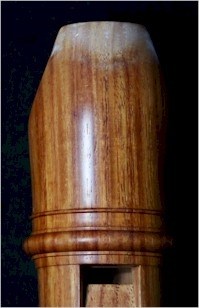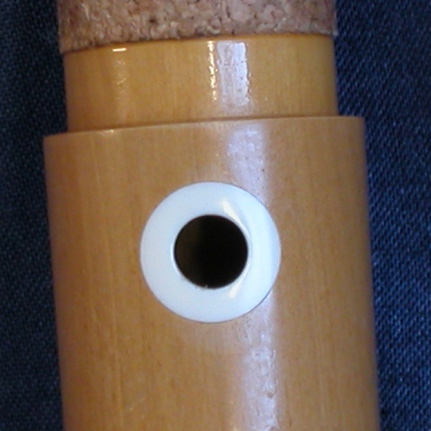For many of us, our most cherished possessions are our wooden recorders. Learning to play them is one challenge; learning to care for them is another! The most important way to care for your recorder is to not get it dirty in the first place.
There are three things you can do to keep your recorder playing its best:
-
 Brush your teeth before playing,
Brush your teeth before playing,
-
Don’t eat blue cheese, which introduces mold spores into the windway,
-
Wash your hands.
Simple, right? The above steps will go a long way towards keeping your recorders in top condition, but there are a few more things you can do:
-
Break it in following the maker’s instructions (see links at the bottom of this article).
-
Warm it up before playing it each time.
-
Use a moisture sheeting solution (Dupenol or one part dish detergent to four parts water) to prevent water beading in the windway.
-
Dry the interior with a lint-free cloth after playing, NOT a fuzzy swab, which may leave lint in your bore. Leave the recorder out of its case to dry.
-
Replace and/or rewind string joints. If the joint is too loose, unwind a yard of thread and wind it on again. Don’t be afraid to unwind several yards of thread and wind it on again. It is infinitely adjustable.
You can also keep your recorder looking its best:
-
 Remove calcium from the beak: This is much easier than you think. Lay a strip of folded tissue paper across the beak where calcium has accumulated. Wet it with white vinegar. Keep it moist and in place for five minutes, up to 30 minutes if the accumulation is heavy. The vinegar will dissolve the calcium. Wash the area with mild soap and water. Use a terry or microfiber cloth to wipe off any remaining residue. Prevent it from developing again by wiping your beak with a damp cloth after playing it. You can rinse the beak under running tap water too.
Remove calcium from the beak: This is much easier than you think. Lay a strip of folded tissue paper across the beak where calcium has accumulated. Wet it with white vinegar. Keep it moist and in place for five minutes, up to 30 minutes if the accumulation is heavy. The vinegar will dissolve the calcium. Wash the area with mild soap and water. Use a terry or microfiber cloth to wipe off any remaining residue. Prevent it from developing again by wiping your beak with a damp cloth after playing it. You can rinse the beak under running tap water too.
-
Wash the exterior of the instrument. We recommend using a microfiber or terry cloth for this since they don’t damage wood. Feel free to add some mild dish soap if needed. Rinse when done. Avoid getting string joints wet if possible. Cork joints aren’t a problem. Keep leather keypads dry too.
To oil or not to oil?
-
DON’T OIL THE BLOCK! The block, which is the removable insert of wood on which your lower lip rests, is designed to absorb moisture. This means you can't oil the windway unless you can remove the block.
-
Oil the exterior to keep your recorder looking pretty. Almost every maker recommends sweet almond oil with vitamin e oil added to it. The vitamin e oil keeps the almond oil from going rancid. Allow the oil enough time to soak in, at least for an hour. Wipe it off completely so your recorder doesn’t get sticky from oil residue.
-
Oil the bore. Check the instructions of the recorder maker.
Despite your best intentions, sometimes recorders need more help. The majority of problems with recorders occur when there are problems within the windway. However, most players are uncomfortable removing a block from their recorder, and if that is the case, and you are experiencing any of the following difficulties, please send your instrument to a professional. A professional can remove the block to clean it and the windway properly, oil the head, and make sure the original dimensions of the windway are restored. If you encounter these difficulties, it’s time to consult a pro:
-
Your instrument no longer easily hits high notes.
-
It clogs easily and adding an anti-condense solution does not help.
-
When the instrument doesn’t play the lovely way you remember it playing.
 Other reasons to send your recorder to a pro:
Other reasons to send your recorder to a pro:
Adding a thumbbushing (a reinforcement to a damaged thumb hole)
Installing new cork on a joint
Happy playing!



 Brush your teeth before playing,
Brush your teeth before playing, Remove calcium from the beak: This is much easier than you think. Lay a strip of folded tissue paper across the beak where calcium has accumulated. Wet it with white vinegar. Keep it moist and in place for five minutes, up to 30 minutes if the accumulation is heavy. The vinegar will dissolve the calcium. Wash the area with mild soap and water. Use a terry or microfiber cloth to wipe off any remaining residue. Prevent it from developing again by wiping your beak with a damp cloth after playing it. You can rinse the beak under running tap water too.
Remove calcium from the beak: This is much easier than you think. Lay a strip of folded tissue paper across the beak where calcium has accumulated. Wet it with white vinegar. Keep it moist and in place for five minutes, up to 30 minutes if the accumulation is heavy. The vinegar will dissolve the calcium. Wash the area with mild soap and water. Use a terry or microfiber cloth to wipe off any remaining residue. Prevent it from developing again by wiping your beak with a damp cloth after playing it. You can rinse the beak under running tap water too. Other reasons to send your recorder to a pro:
Other reasons to send your recorder to a pro: